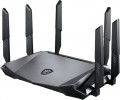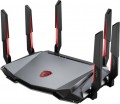Wi-Fi standards
Wi-Fi standards supported by the equipment. Nowadays, in addition to modern standards
Wi-Fi 4 (802.11n),
Wi-Fi 5 (802.11ac),
Wi-Fi 6 (802.11ax)(its variation
Wi-Fi 6E),
Wi-Fi 7 (802.11be) and
WiGig (802.11ad), you can meet also support for earlier versions —
Wi-Fi 3 (802.11g) and even Wi-Fi 1 (802.11b). Here is a more detailed description of each of these versions:
— Wi-Fi 3 (802.11g). An outdated standard, like Wi-Fi 1 (802.11b), which has sunk into oblivion. It was widely used before the advent of Wi-Fi 4, nowadays it is used mainly as an addition to newer versions — in particular, in order to ensure compatibility with outdated and low-cost equipment. Operates at a frequency of 2.4 GHz, the maximum data transfer rate is 54 Mbps.
— Wi-Fi 4 (802.11n). The first of the common standards that supports the frequency of 5 GHz; can operate in this range or in the classic 2.4 GHz. It is worth emphasizing that some models of Wi-Fi equipment for this standard use only 5 GHz, which is why they are incompatible with earlier versions of Wi-Fi. The maximum speed for Wi-Fi 4 is 600 Mbps; in modern wireless devices, this standard is very popular, only recently it began to be squeezed into this position by Wi-Fi 5.
— Wi-Fi 5
...(802.11ac). The successor to Wi-Fi 4, which finally moved to the 5 GHz band, which had a positive effect on the reliability of the connection and data transfer rate: it is up to 1.69 Gbps per antenna and up to 6.77 Gbps in general. In addition, this is the first version to fully implement Beamforming technology (for more details, see "Functions and Capabilities").
— Wi-Fi 6, Wi-Fi 6E (802.11ax). The development of Wi-Fi 5, which introduced both an increase in speed to 10 Gbps, and a number of important improvements in the format of work. One of the most important innovations is the use of an extensive frequency range — from 1 to 7 GHz; this, in particular, allows you to automatically select the least loaded frequency band, which has a positive effect on the speed and reliability of the connection. At the same time, Wi-Fi 6 devices are capable of operating at classic frequencies of 2.4 GHz and 5 GHz, and a modification of the Wi-Fi 6E standard is capable of operating at frequencies from 5.9 to 7 GHz, it is generally accepted that devices with Wi-Fi 6E support operate on frequency of 6 GHz, while there is full compatibility with earlier standards. In addition, some improvements were introduced in this version regarding the simultaneous operation of several devices on one channel, in particular, we are talking about OFDMA technology. Thanks to this, Wi-Fi 6 gives the smallest of modern standards a drop in speed when the air is loaded, and the modification of Wi-Fi 6E operating at a frequency of 6 GHz has the least amount of interference.
— Wi-Fi 7 (802.11be). This Wi-Fi standard began to be implemented in 2023. Thanks to the use of 4096-QAM modulation, a maximum theoretical data rate of up to 46 Gb / s can be squeezed out of it. Wi-Fi 7 supports three frequency bands: 2.4 GHz, 5 GHz and 6 GHz. The maximum bandwidth in the standard has been increased from 160 MHz to 320 MHz - the wider the channel, the more data it can transmit overnight. Among the interesting innovations in Wi-Fi 7, the development of MLO (Multi-Link Operation) is noted - with its help, connected devices exchange data using several channels and frequency bands simultaneously, which is especially important for VR and online games. The Multiple Resource Unit technology is designed to minimize communication delays when there are many connected client devices. The new 16x16 MIMO protocol is also aimed at increasing throughput with a large number of simultaneous connections, doubling the number of spatial streams compared to the previous Wi-Fi 6 standard.
WiGig (802.11ad). Wi-Fi standard using an operating frequency of 60 GHz; data transfer rates can be up to 10 Gbps (depending on the specific version of WiGig). The 60 GHz channel is much less loaded than the more popular 2.4 GHz and 5 GHz, which has a positive effect on the reliability of data transmission and reduces latency; the latter is especially important in games and some other special tasks. On the other hand, the increase in frequency has significantly reduced the connection range (for more details, see "Frequency range"), so that in fact this standard is only suitable for communication within the same room.
Note that in fact, the data transfer rate is usually much lower than the theoretical maximum — especially when several Wi-Fi devices operate on the same channel. Also note that different standards are backwards compatible with each other (with a speed limit according to the slower one) provided that the frequencies match: for example, 802.11ac can work with 802.11n, but not with 802.11g.Frequency band
Standard Wi-Fi frequency bands supported by the device.
This parameter is directly related to the Wi-Fi standards (see above) that the equipment complies with. At the same time, there are standards that cover several bands at once (such as Wi-Fi 4 and Wi-Fi 6), and not every device compatible with them supports all these bands at once; so in such cases this point should be clarified separately. In addition, the frequencies commonly used nowadays have common features, here they are:
— 2.4 GHz. Classic range: used in the earliest Wi-Fi standards, and supported by many modern versions. Therefore, quite a lot of Wi-Fi equipment still works
only at 2.4 GHz(although exceptions are increasingly common). The main advantages of such equipment are simplicity, low cost, and compatibility even with frankly outdated wireless devices. On the other hand, the 2.4 GHz band is extremely busy: in addition to numerous Wi-Fi devices, it is also used by Bluetooth modules and some other types of electronics. This may degrade the quality and speed of the connection.
— 5 GHz. A band introduced to overcome the shortcomings of 2.4 GHz — in particular, to offload communication channels and separate Wi-Fi from other wireless technologies. In addition, increasing the frequency allowed to increase the communication speed. 5 GHz is used as one of the operating frequencies in the Wi-Fi 4 and Wi-Fi 6 standards (see above) and as the only one
...in Wi-Fi 5. So you can find devices on the market that operate only at 5 GHz, but more widespread received equipment with multiple bands, where this frequency is only one of the supported.
— 6 GHz. An unloaded frequency introduced into use since the Wi-Fi 6E generation. The new range provides the ability to simultaneously operate numerous client devices at high speed with a minimum amount of interference and delays in signal transmission. At the moment, this is the freest, widest and fastest Wi-Fi range. However, in some regions, the 6 GHz frequency remains unavailable due to the occupancy of the band by means of military, fixed or radio relay wireless communications.
— 60 GHz. Range implemented in the WiGig standard; today it is used only in it, and as the only one. A significant increase in frequency compared to the more common 2.4 GHz and 5 GHz options has a positive effect on the quality of communication. So, with the same theoretical maximum as that of Wi-Fi 6 (10 Gbps), the WiGig standard gives a higher actual data exchange rate, as well as fewer delays and lags; this is especially important in games and some specific tasks. The downside of these advantages is a small communication range: even when using Beamforming (see "Functions and Capabilities"), it does not exceed 10 m in open space, and an obstacle like a wall can become insurmountable for a 60 GHz channel. Therefore, in Wi-Fi equipment, this frequency is found mainly among rather specific devices — access points (including directional ones), which are designed to connect individual network segments in bridge mode (see ibid.). It is this mode of use that is one of the most optimal, given the properties of this range. However, 60 GHz support is also increasingly found in consumer gadgets (smartphones, laptops), so routers are also being released for this frequency.
— Natural frequency. In rare cases, the operation of Wi-Fi equipment is possible at natural frequencies that do not fall under the standard generally accepted values. Such devices are mainly used to build point-to-point and point-to-multipoint radio bridges. Their advantages include low frequency noise from standard Wi-Fi networks, and, as a result, increased communication range. It is worth noting that it is impossible to connect directly to such devices from a laptop or smartphone. It is also necessary to take into account the legislative aspect, since in each country the use of frequencies is regulated differently.Operating ranges
The number of wireless bands and channels supported by the router. Specified only for models that work with more than one range.
—
Dual-band (2.4 GHz and 5 GHz). Devices that simultaneously support two popular communication bands — 2.4 GHz and 5 GHz — in the "one communication channel per band" format. This ensures compatibility with most Wi-Fi standards (see above), and in some cases also has a positive effect on the quality of communication. For example, a Wi-Fi adapter (see "Device Type") with this feature may provide the ability to evaluate the load on both bands and automatically select the less loaded one.
—
Three-channel (2.4 GHz and 5 GHz in 2 channels). An improved version of the dual-band operation format: in the 5 GHz band, communication is carried out on two channels. This allows, for example, to “raise” three wireless connection channels on one router at once (three visible networks in the list of wireless networks) and achieve even higher throughput. The advantages of this format are especially noticeable when the router works simultaneously with several wireless devices.
—
Tri-band (2.4 GHz, 5 GHz, 60 GHz). The most "omnivorous" type of modern Wi-Fi equipment, compatible with all popular standards — from the outdated 802.11 b / g to the relatively new 802.11 ad. Also, the abundance of ranges contributes to an increase in spee
...d, especially when working with multi-range devices.Wireless speed 5 GHz
The maximum speed supported by the device when communicating wirelessly in the 5 GHz band.
This range is used in Wi-Fi 4, Wi-Fi 6 and Wi-Fi 6E as one of the available bands, in Wi-Fi 5 as the only one (see "Wi-Fi Standards"). The maximum speed is specified in the specifications in order to indicate the real capabilities of specific equipment - they can be noticeably more modest than the general capabilities of the standard. Also, in fact, it all depends on the generation of Wi-Fi. For example, devices with Wi-Fi 5 support can theoretically deliver up to 6928 Mbit (using eight antennas), with Wi-Fi 6 support up to 9607 Mbit (using the same eight spatial streams). The maximum possible communication speed is achieved under certain conditions, and not every model of Wi-Fi equipment fully satisfies them. Specific figures are conditionally divided into several groups: the value
up to 500 Mbit is rather modest, many devices support speeds in the range of
500 - 1000 Mbit, indicators of
1 - 2 Gbps can be attributed to the average, and the most advanced models in class provide a data exchange rate of
over 2 Gbps.
Wireless speed 6 GHz
The maximum speed supported by the device when communicating wirelessly in the 6 GHz band.
Lighting
A stylish design element for gaming and design models of Wi-Fi equipment in the form of decorative LED
lighting. It can be either single colour or iridescent with colour control (RGB).

